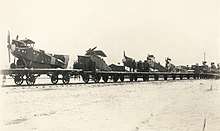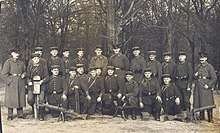West Russian Volunteer Army
The West Russian Volunteer Army or Bermontians was an army in the Baltic provinces of the former Russian Empire during the Russian Civil War in 1918–20.
| West Russian Volunteer Army | |
|---|---|
 Only surviving flag of the West Russian Volunteer Army. | |
| Active | 1918–20 |
| Allegiance | |
| Size | 50,000 |
| Engagements | Russian Civil War |
| Commanders | |
| Notable commanders | Gen. Pavel Bermondt-Avalov Gen. Rüdiger von der Goltz |
| Insignia | |
| Army Flag |  |
History
The Western Russian Volunteer Army, unlike the pro-Entente Volunteer Army, was supported and in fact created by Germany. The Compiègne Armistice, article 12, stipulated that German troops were to remain in the Baltic provinces to help fight Bolshevik advances and were to withdraw once the Allies determined the situation was under control. The order to withdraw was given after the Treaty of Versailles was signed in June 1919.
However, only a small portion of the Freikorps in the Baltic retired; the rest stayed under the leadership of General Rüdiger von der Goltz. To avoid casting blame on Germany and infuriating the Allies, he withdrew into the background and merged his troops with the "Special Russian Corps", led by Cossack General Pavel Bermont-Avalov. The two generals recruited about 50,000 men: mostly Freikorps, Baltic Germans, as well as some Russian POWs captured by Germany in World War I and then released on the promise that they would help fight against the Bolsheviks in the Russian Civil War. The Army declared that it joined the forces of Aleksandr Kolchak and marched to attack Bolsheviks, but their real goal was to sustain German power in the Baltic region.
Confrontation with the Republics of Latvia and Lithuania

The political situation in Baltic region continued to deteriorate. A new government in Lithuania refused to allow White Russians to pass troops through and establish a military base. After initially supporting the White Russians the Weimar government, under pressure from the Entente, banned the transfer of German soldiers to the Russians and ordered the Reichswehr to block the East Prussian border to block Freikorp's supplies. General von der Goltz was finally recalled on October 4.
In this circumstances Bermondt-Avalov launched an offensive using Freikorps in attempt to force the Republic of Latvia to negotiate. With the support of British naval artillery and Estonian Panzerzug, a Latvian counter-offensive followed in November, which forced Bermondt's army to withdraw. Mitau was also lost in loss-making fights.
In October 1919, the West Russian Volunteer Army attacked the newly independent states of Lithuania and Latvia, to which Germany had granted independence. It briefly occupied the west bank of the Daugava river in Riga and the government of Kārlis Ulmanis had to request military assistance from Lithuania and Estonia. The Estonians sent two armoured trains to aid the Latvians (according to some explanations, in exchange for Latvia ceding the island of Ruhnu and its territorial waters to Estonia) while the Lithuanians were engaged in battles with the Bolsheviks and could only issue diplomatic protests. The Latvians also received assistance from the guns of a British Royal Navy destroyer, HMS Vanoc, in Riga harbour.
In November, the Latvian army managed to drive the Bermont-Avalov forces into Lithuanian territory. Mitau was also lost. Finally, the West Russian Volunteer Army suffered heavy defeats by the Lithuanians near Radviliškis, a major railway centre.
Upon defeat Bermondt-Avalov fled to Denmark. The German Freikorps were handed over to the German Lieutenant General von Eberhardt, successor of the Goltz as commander of the VI Reserve Corps in Allenstein. After the involvement of the Entente military mission, General Eberhardt was able to organize evacuation of the remaining German Freikorps via Lithuania to East Prussia. This was completed by mid-December 1919.
Army
The Army uniforms of the West Russian Volunteer Army were provided by Germany and decorated with Russian distinctive signs, in particular the shoulder legs according to the model of the Russian Imperial Army and an Orthodox cross worn on the left sleeve.
The army included:[1]
- Corps Graf Keller (Colonel Potozki): around 10,000 / 7,000 soldiers, near Jelgava
- Corps Virgolitsch (Colonel Virgolitsch): about 5,000 / 3,500 soldiers, stationed in northern Lithuania
- Iron Division (Major Bischoff): about 18,000 / 15,000 soldiers, at Jelgava, joined in August
- German Legion (Captain Sievert): about 12,000 / 9,000 soldiers who had come together from various independent free corps.
- Freikorps Plehwe (Captain von Plehwe): about 3,000 soldiers (the former 2nd Guard Reserve Regiment), before Libau
- Freikorps Diebitsch : about 3,000 soldiers, for railway protection in Lithuania.
- Freikorps Roßbach : about 1,000 soldiers, appeared at the end of October after a march over 1,200 km off Riga.

See also
References
- Inta Pētersone (ed.): Latvijas Brīvības cīņas 1918–1920. Enciklopēdja. Preses nams, Riga 1999, ISBN 9984-00-395-7, page 78.
- Simas Sužiedėlis, ed. (1970–1978). "Bermondtists". Encyclopedia Lituanica. I. Boston, Massachusetts: Juozas Kapočius. pp. 335–336. LCC 74-114275.
Bibliography
- Von der Goltz, Rüdiger (1920). Meine Sendung in Finnland und im Baltikum (in German). Leipzig: Verlag von K.F. Koehler. OCLC 186846067.
- Bermondt-Avalov, Pavel (1925). Im Kampf gegen den Bolschewismus. Erinnerungen von General Fürst Awaloff, Oberbefehlshaber der Deutsch-Russischen Westarmee im Baltikum (in German). Glückstadt, Hamburg: Verlag J.J. Augustin. OCLC 15188750.
- Bischoff, Josef, Die letzte Front. Geschichte der Eiserne Division im Baltikum 1919, Berlin 1935.
- Darstellungen aus den Nachkriegskämpfen deutscher Truppen und Freikorps, Bd 2: Der Feldzug im Baltikum bis zur zweiten Einnahme von Riga. Januar bis Mai 1919, Berlin 1937; Bd 3: Die Kämpfe im Baltikum nach der zweiten Einnahme von Riga. Juni bis Dezember 1919, Berlin 1938.
- Die Baltische Landeswehr im Befreiungskampf gegen den Bolschewismus, Riga 1929.
- Eesti Vabadussõda 1918-1920, Tallinn, Mats, 1997. ISBN 9985-51-028-3.
- Kiewisz, Leon, Sprawy łotewskie w bałtyckiej polityce Niemiec 1914-1919, Poznań 1970.
- Paluszyński, Tomasz, Walka o niepodległość Łotwy 1914-1920, Warszawa 1999.
- Von den baltische Provinzen zu den baltischen Staaten. Beiträge zur Entstehungsgeschichte der Republiken Estland und Lettland, Bd I (1917-1918), Bd II (1919-1920), Marburg 1971, 1977.